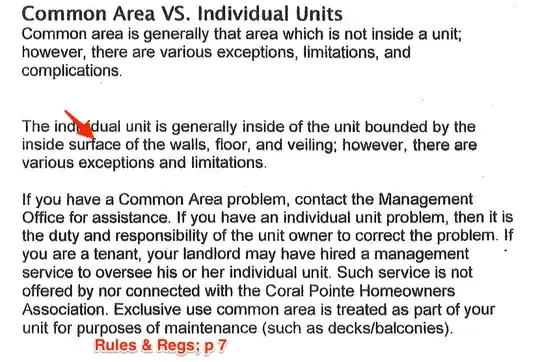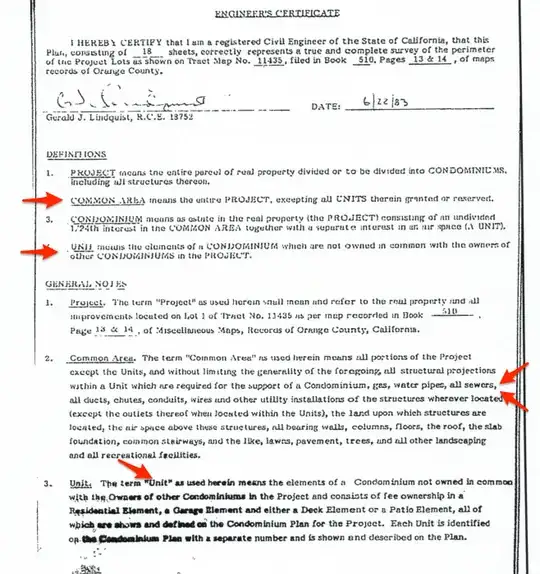I wanted some help on one particular part of a "case" I'm putting together to present to my HOA. Long story short, I had a leak in my wall from a drain line from my kitchen sink. It damaged the unit below me a little bit. In my mind, this was unquestionably HOA domain because the leak was within the wall (behind the studs). The HOA reviewed the CC&Rs and found a tidbit about "leaks between units" being the responsibility of owners and stuck me with the bill.
I (and they) apparently did not have the Condominium Plan on-hand so I got it repaired since I didn't have much ammo to argue with them. I've since obtained the condo plan and it pretty clearly places the ownership of "sewer lines" on the HOA.
What I want is a little help exploring the legal definition of the term "outlet" though, as it grants an exception for "outlets within units".
I just want to make sure they can't turn it around on me, especially since the wall in question is a wall in the middle of my unit and the condo plan only shows the four outer walls.
This is my "case" so far: (Copy/paste with some mods)
Per [the HOA president] meeting email, he points out this from the Regulations:
“ the HOA not being responsible for water leaks between units or interior damage.”
This is in reference to sections in the CC&Rs and Regulations that were discussed at the 12/7 HOA meeting with reference, in part, to the leak that occurred from a drain line in my wall.
There was confusion stemming primarily from the fact that the CC&Rs don’t specify one way or the other, in short, “who owns the pipes” in their text. Jonathan reviewed the documents and essentially took it as implied that since leaks between units are the domain of owners, then pipes that leak are the domain of owners too. The notion that the pipes and drains in the walls belong to the individual owners did not sound correct to me though, for a few reasons, but essentially it "didn't sound right".
At the time, Jonathan invited me to review our Condo’s documents if I disagreed with the conclusion. Here’s my findings:
Jonathan’s analysis hinged primarily on this portion of our “Rules and Regulations”:
LEAKS BETWEEN UNITS Please be aware that damages to adjoining units are the responsibility of the unit owner where the leak originated....
The main question this raises is “What is defined, in concrete terms, as a Unit?”
There is some guidance in the Rules & Regs themselves a few pages earlier, laying a general rule that a “Unit” is inside of a “unit” bounded by the surface of walls, floors, etc:
It notes some exceptions and is self-referential, so let’s see about getting a more authoritative answer on what a Unit is. This can be found in the CC&Rs:
1.43. Separate Interest or Unit. Separate Interest or unit, which shall consist of a “Residential Element", a “Garage Element”, and either a'“Deck Element” or a “Patio Element", shall mean a separate interest in space as as defined in Section 1351 (f) of the California Civil Code. Each Separate Interest or Unit shall be a separate freehold estate, as separately shown, numbered and designated in the Condominium Plan. In interpreting deeds, declarations and plans, the existing physical boundaries of the Unit or a unit constructed or reconstructed in substantial accordance with the Condominium Plan and the original plans hereof, if such plans are available, shall be conclusively presumed to be its boundaries rather than the description exPressed in the deed Condominium Plan or Declaration, regardless of settling or lateral movement of the building and regardless of minor variances between boundaries, as shown on the Condominium Plan- or defined in the deed and Declaration, and the boundaries of a building as constructed or reconstructed.
The main part of this is that units are defined on the Condo Plan. This is where my analysis came to a grinding halt for weeks as I tried to figure out, well, what and where is the condo plan?
In short, it is a map with the specific graphs and definitions for who owns everything. It’s supposed to have been part of what I received from our management company but I confirmed it wasn’t included, and further, that they did not have a copy of it when I asked them to look.
I eventually went a little more granular and asked “What exactly do I legally own?” in an effort to find it and though to check my Deed:
redacted :)
[It referenced the Condo Plan by instrument number at the County]. I obtained a copy from the County Clerk Recorder’s office using this information.
It has some diagrams and the like, but the most important part is in the first few pages, in the “Definitions” section:
Here we find the final word on what is a “Unit”, therefore my direct responsibility to maintain, and what is “Common Area”, therefore the HOA’s responsibility to maintain.
As you can see, “all sewers” are specifically called out as common area, as well as “water pipes” etc. This is further supported by the earlier assessment that anything that is not within the “surfaces” of a unit is also common area. Which, coming back to the CC&Rs, places it squarely in the domain of the HOA, which is responsible for …”repairs… of the Common Area”:
[you get the idea and I don't have enough SE rep to post more links...]
To reiterate, What I want is a little help exploring the legal definition of the term "outlet" though, as it grants an exception for "outlets within units". Other observations and feedback on my legal reasoning is welcome as well though :)

